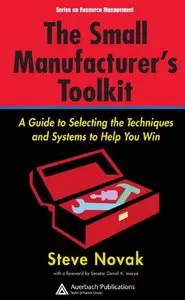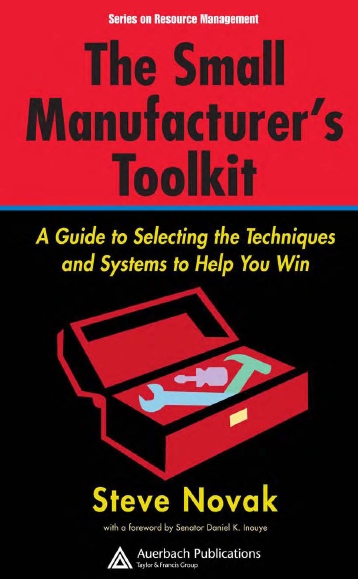"The Small Manufacturer's Toolkit: A Guide to Selecting the Techniques and Systems to Help You Win" by Steve Novak
Taylor & Francis, Auerbach Publications | 2006 | ISBN: 0849328837 9780849328831 | 437 pages | PDF | 4 MB
Taylor & Francis, Auerbach Publications | 2006 | ISBN: 0849328837 9780849328831 | 437 pages | PDF | 4 MB
This book guides you through the philosophies that are constantly being promoted, enabling you make informed choices. The book discusses Lean Manufacturing and the often accompanying Six Sigma, as well as the aspects of the Theory of Constraints that may cause confusion and prevent implementation. The book reviews many of the most popular quality tools and quality management systems, fostering an understanding of what should be the foundation of any organization. The book concludes by providing a diagnostic tool that helps you determine which tools, or aspects of tools, are valid for your organization.
Small manufacturers often lack the resources and expertise needed to choose the management philosophies and process improvement techniques that could provide the most benefit to their bottom line. Sorting through all of the available tools and deciding which ones to adopt can be overwhelming. Following an introductory chapter, the author addresses fundamental inventory management and planning tools, including the Sales Operations Planning process that bridges the high-level strategic plan and the midrange master production schedule.
The text also explores project management, and examines the requirements surrounding the implementation and use of ERP systems. It emphasizes awareness and application of Supply Chain Management techniques, and covers productive E-Commerce related applications.
Contents
1 Assembling Your Toolkit
1.1 Knowledge Is Power
1.2 Assembling Your Tools
1.3 Challenges of the Small Manufacturer
SECTION I Materials Management
2 The Basics: Are You at the Starting Line?
2.1 Inventory Basics
2.1.1 Why Do You Have Inventory?
2.1.2 Part Numbering
2.1.3 Item Descriptions
2.1.4 Bills of Material
2.1.5 Inventory Accuracy
2.2 Master Production Scheduling
2.2.1 Planning Hierarchy
2.2.2 Volume versus Mix
2.2.3 Disaggregation
2.2.4 Forecasting
2.2.5 Planning Horizon
2.2.6 Time Fences
2.2.7 Capacity
2.2.8 Rated Capacity
2.3 Materials Requirements Planning
2.3.1 Capacity
2.4 Warehousing Basics
2.4.1 Layout, Picking, and Putaway
2.4.2 The Warehouse as a Strategic Weapon
2.4.3 Technology in the Warehouse
3 Sales and Operations Planning: Know Where You’re Going
3.1 Volume versus Mix
3.2 The Sales and Operations Planning Process
3.3 The Sales Plan
3.3.1 Forecasting
3.3.2 Characteristics of Forecasts
3.3.3 Demand
3.3.4 Some Forecasting Methods
3.3.5 From Forecast to Sales Plan
3.4 The Operations Plan
3.5 The Financial Plan
3.6 Tying It All Together
3.6.1 Capacity Check
3.6.2 New Products
3.7 What It Takes to Get Started
SECTION II Manufacturing Operations
4 Lean Manufacturing: Power Tools!
4.1 Lean on the Shop Floor
4.1.1 Elimination of Waste
4.1.2 Cellular Manufacturing
4.1.3 Lot Size 1
4.1.4 Inventory Reduction
4.1.5 Pull System
4.1.6 Kanban
4.1.7 Mixed-Model Scheduling
4.1.8 SMED — Setup Time Reduction
4.1.9 Kaizen
4.1.10 5S
4.1.11 Value Stream Mapping
4.1.12 Poka-Yoke
4.1.13 Quality
4.2 Terms and Techniques
4.3 Planning in a Lean Environment
4.4 Maintenance
4.5 The Lean Enterprise — Not Just for Manufacturing
4.6 The Lean Supply Chain
4.7 A Little Lean
5 Six Sigma for the Little Guy: Uh-Oh — Math.
5.1 Sigma
5.2 The Normal Distribution
5.3 More about Those Sigmas
5.4 Six Sigma Performance
5.5 DMAIC/PDCA
5.6 Customer Focus
5.7 Just the Facts
5.8 Green Belts, Black Belts, and Beyond
5.9 Project Selection
5.10 More Six Sigma Tools
5.11 Where to Start
6 Theory of Constraints: Think!
6.1 A Note on The Goal
6.2 Drum-Buffer-Rope
6.2.1 Buffers and Buffer Management
6.3 The Five Focusing Steps
6.3.1 Step 1 — Identify the System’s Constraint(s)
6.3.2 Step 2 — Decide How to Exploit the System’s Constraint(s)
6.3.3 Step 3 — Subordinate Everything Else to the Above Decisions
6.3.4 Step 4 — Elevate the System’s Constraint(s)
6.3.5 Step 5 — Go Back to Step 1?
6.3.6 Change
6.4 Throughput and Throughput Accounting
6.5 The Thinking Processes
6.5.1 Evaporating Clouds
6.5.2 Current Reality Tree
6.5.3 Future Reality Tree
7 Quality Tools: You’ve Heard about Them; What Are They?
7.1 Total Quality Management (TQM)
7.2 Statistical Process Control
7.2.1 Control Charts
7.2.2 Principles of Statistical Process Control
7.3 ISO 9000
7.3.1 ISO 9000:2000 Requirements
7.4 The Malcolm Baldrige National Quality Award
7.4.1 The Award Criteria
7.4.2 Scoring
7.4.3 Application and Review Process
7.5 The Quality Organization
7.5.1 Defining Quality
7.5.2 Quality Strategy
7.5.3 Quality Policies
7.5.4 Quality Functions
7.5.5 Organizational Environment
7.5.6 Quality Resources
7.5.7 Cost of Quality
7.5.8 More Quality Tools
7.5.8.1 The PDCA Cycle
7.5.8.2 Process Maps, Flowcharts, and Value Stream Maps
7.5.8.3 Ishikawa Diagram
7.5.8.4 Pareto Analysis
7.5.8.5 Activity Network Diagram
7.5.8.6 Brainstorming
7.5.8.7 Affinity Diagram
7.5.8.8 Interrelationship Digraph
7.5.8.9 Force Field Analysis
7.6 Metrics
SECTION III Management of the Business
8 Project Management: You’re Gonna Do It; Do It Right
8.1 Project Phases
8.1.1 Phase 1 — Initiating Phase
8.1.2 Phase 2 — Planning Phase
8.1.3 Phase 3 — Execution Phase
8.1.4 Phase 4 — Control Phase
8.1.5 Phase 5 — Closing Phase
8.2 Project Scope
8.2.1 Scope Planning
8.2.2 Scope Definition
8.2.3 Scope Management
8.3 Resources
8.4 Risk Management
8.5 Miscellaneous Issues
8.6 Critical Chain Project Management
9 ERP: Information at the Speed of Light
9.1 What Is ERP and Why Would I Want It?
9.2 History and Evolution
9.3 Modules and Functions
9.4 Selection
9.5 Education and Training
9.5.1 Learning Requirements Planning
9.5.2 Education Providers
9.6 Implementation
9.6.1 The Implementation Team
9.6.2 The Proven Path
9.7 Maintenance
9.7.1 Upgrades
9.7.2 Data Integrity
9.7.3 Employee Turnover
10 Supply Chain Management: You’re Not Alone
10.1 You Don’t Operate in a Vacuum
10.2 Supply Chain Management
10.2.1 Information Chain
10.2.2 Value Chain
10.2.3 Variation in the Supply Chain
10.2.4 Working with Suppliers and Customers
10.2.5 Network Planning
10.2.6 Distribution Requirements Planning
10.2.7 Reverse Logistics
10.2.8 Design for Logistics
10.2.9 Outsourcing
10.2.10 Technology
10.3 Plossl’s Seven Supply Chain Points
11 E-Commerce: Entering the 21st Century
11.1 E-Commerce Is Not Just Creating a Web Site
11.2 EDI and Sons
11.3 World Wide Web: Two Sides of the Coin
11.3.1 Business-to-Consumer (B2C)
11.3.2 Business-to-Business (B2B)
11.3.3 Security
11.4 The Back End Is Just as Important as the Front End
11.5 Inventory and Operations Planning
SECTION IV Diagnostics and Decisions.
12 Now What?
12.1 Which Tools Are Right for Me?
12.1.1 A Selection Tool
12.1.2 Change Management
12.2 Application of Tools
12.2.1 The Basics
12.2.2 Sales and Operations Planning
12.2.3 Lean Manufacturing
12.2.4 Six Sigma
12.2.5 Theory of Constraints
12.2.6 Statistical Process Control
12.2.7 ISO 9000
12.2.8 Malcolm Baldrige National Quality Award Criteria
12.2.9 Project Management
12.2.10 Enterprise Resource Planning
12.2.11 Supply Chain Management
12.3 E-Commerce
12.4 Service — Your Competitive Weapon (But I’m a Manufacturer!)
12.5 The Last Word
Appendix A
References and Resources
A.1 Organizations
A.2 Books
A.3 Magazines
A.4 Articles
Appendix B
Normal Distribution versus Sigma Conversion
Index
with TOC BookMarkLinks



